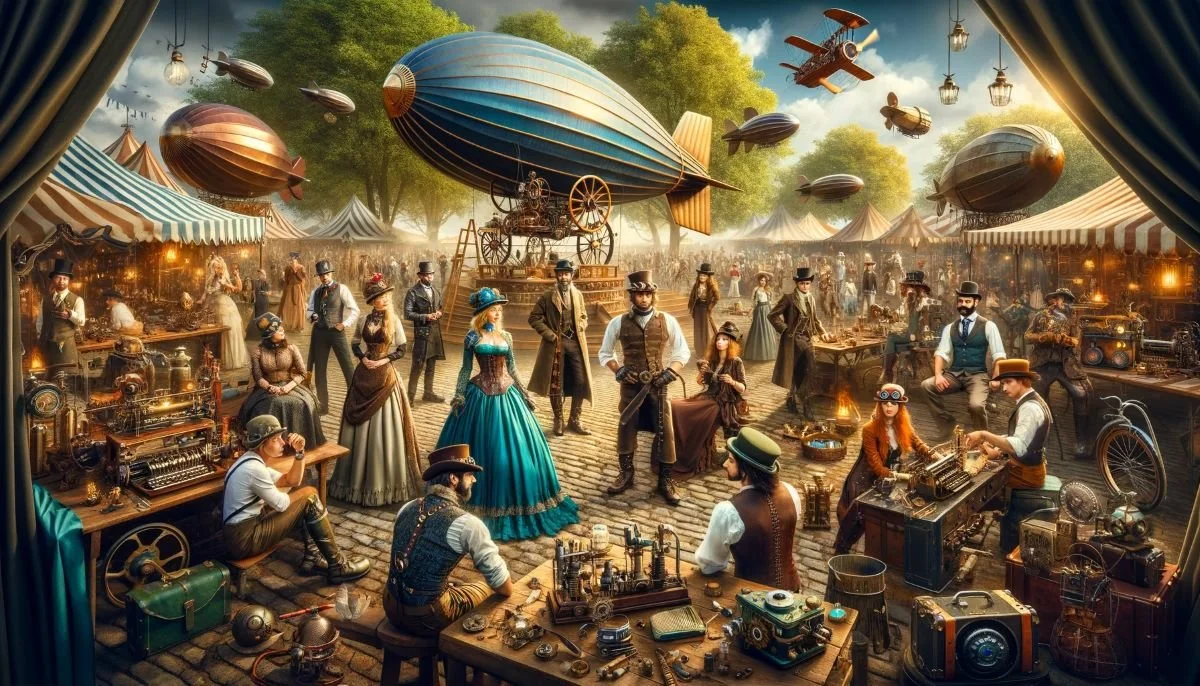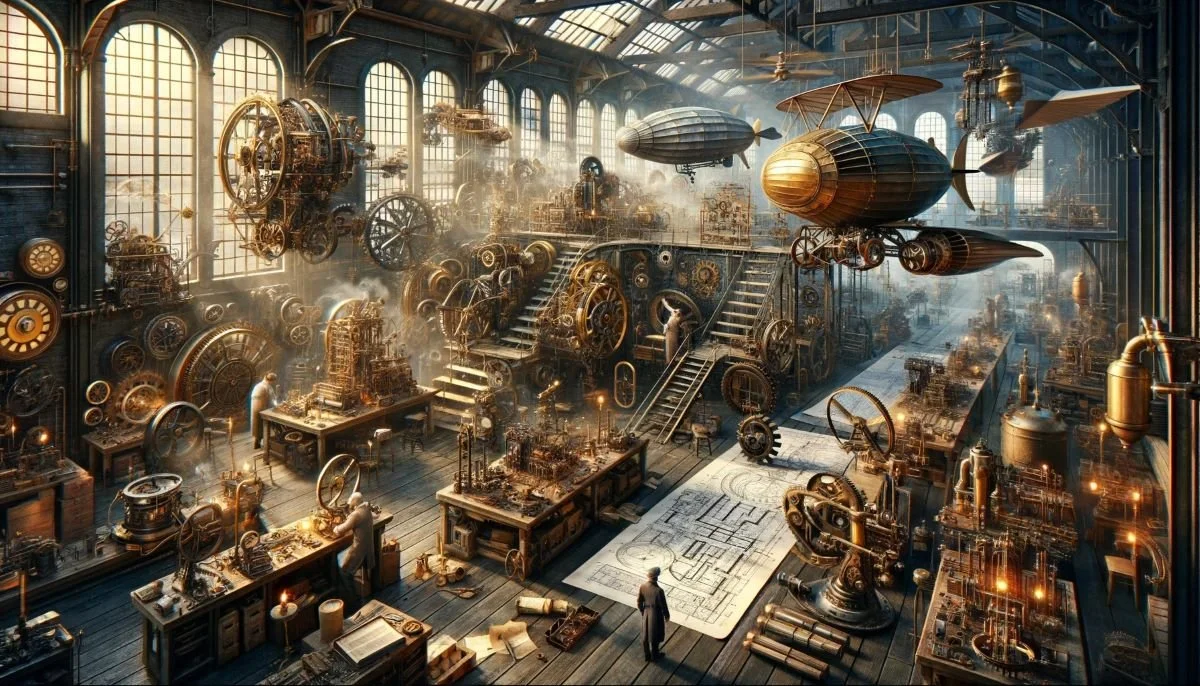Explore the fascinating world of Steampunk communities and subcultures, a global phenomenon where the past and future collide in a vibrant celebration of creativity and imagination. This article delves into the development, characteristics, and unique aspects of these communities.
Unveiling the World of Steampunk Subcultures
Welcome to the whimsical and inventive world of Steampunk subcultures, where the past and the future collide in a spectacle of brass gears, corseted elegance, and imaginative creativity. Steampunk, a term that initially conjured images of airships in Victorian skies and steam-powered gadgets in alternate histories, has transcended its literary and media origins to foster a vibrant global subculture. Here, we’re not just reading about or watching Steampunk; we’re living it.
Steampunk began as a literary genre, a sibling of sorts to science fiction and fantasy, characterized by its unique blend of 19th-century industrial steam-powered machinery and elements of futuristic innovation. Originating from the visionary minds of authors like Jules Verne and H.G. Wells, Steampunk quickly captured the imagination of readers. However, what started as a niche literary fascination soon evolved into a robust and diverse subculture, spanning the globe and drawing in fans from all walks of life.
But what is it about Steampunk that resonates so deeply with its enthusiasts? At its core, Steampunk is more than just a style; it’s an expression of creativity and an ode to a bygone era, reimagined with a twist of modernity. It’s a rebellion against the mundane, a nod to the artisanal, and a playground for the imagination. From the cobblestone streets of Victorian London to the futuristic fantasies of science fiction, Steampunk offers a unique fusion of historical nostalgia and speculative creativity.
As you step into the world of Steampunk, you enter a realm where the boundaries between history and fantasy blur. Here, corsets and top hats meet goggles and ray guns; elaborate brass contraptions exist alongside intricate clockwork devices. It’s a place where the retro charm of the past meets the limitless possibilities of the future, creating a fascinating paradox that captivates and inspires.
The Steampunk subculture is a testament to the enduring allure of this genre. Across the world, from the back alleys of London to the bustling streets of Tokyo, communities of Steampunk enthusiasts gather to celebrate their shared passion. They come together in grand conventions, intimate meetups, and online forums, each contributing their unique interpretation of Steampunk, making the subculture as diverse and dynamic as the genre itself.
In this article, we’ll dive into the heart of these Steampunk communities. We’ll explore their fashion, their art, their inventions, and most importantly, the spirit of creativity and camaraderie that binds them together. So, adjust your goggles, fasten your waistcoats, and join us on a journey through the extraordinary world of Steampunk subcultures, where every cog and gear tells a story of wonder and ingenuity.
The Birth of Steampunk Subcultures
Historical Roots
Let’s turn back the pages of time to the genesis of Steampunk as a distinct subculture, a fascinating transformation that sprouted from the seeds of literature. Initially, Steampunk was a literary genre, a quirky offshoot of science fiction, distinguished by its fusion of Victorian-era aesthetics and futuristic, often steam-powered, technology. It was a world envisioned by the likes of Jules Verne and H.G. Wells, where the impossible was made possible through the lens of science and the elegance of the 19th century.
But Steampunk was destined to leap off the pages. The vivid and imaginative settings, the intricate gadgets, and the adventurous spirit of these narratives captured the hearts of readers who yearned for more than just words on a page. They craved a tangible connection to this anachronistic world. Thus, the Steampunk subculture was born, propelled by a love for both the historical intricacies of the Victorian era and the boundless possibilities of speculative science fiction.
The Rise of Communities
The expansion of Steampunk from literary roots into a thriving subculture is a testament to the power of community. With the advent of the internet, enthusiasts found a new platform to connect, share ideas, and expand their love for Steampunk beyond individual imaginations. Online forums became digital salons, where people from across the globe could discuss, plan, and dream up their Steampunk creations and stories.
From these virtual communities emerged the desire for physical connection. Local gatherings began to sprout up, ranging from small meetups in cafes to large, elaborate conventions. These events were (and still are) kaleidoscopes of creativity and collaboration, where enthusiasts showcase their handmade costumes, intricate gadgets, and share their interpretations of Steampunk.
Over time, these communities have only grown more diverse and inclusive. What was once a niche interest predominantly rooted in Western perspectives has welcomed a global influence, with Steampunk enthusiasts from different cultures adding their unique flavors to the mix. This diversity has enriched the subculture, making it a vibrant and ever-evolving tapestry of ideas, art, and expression.
In these gatherings, whether online or in person, Steampunk is not just celebrated; it is brought to life. The communities serve as the heart and soul of the subculture, a place where the past and the future coalesce into a present that is as imaginative as it is diverse. In the world of Steampunk subcultures, every cog and corset, every top hat and timepiece, tells a story of a community united by its love for a genre that defies the constraints of time and reality.
Characteristics of Steampunk Subcultures
Steampunk subcultures are not just gatherings; they’re vibrant showcases of creativity, style, and ingenuity. At the core of these communities are two defining characteristics: a unique fashion sense and a strong DIY ethos. Together, they create a vivid, imaginative world that’s as much about self-expression as it is about escapism.
Fashion and Style
Imagine stepping into a world where the past and the future converge in a dazzling display of fashion. This is the sartorial realm of Steampunk. Here, Victorian clothing is not just a nod to historical accuracy but a canvas for personal expression. Men don top hats and waistcoats, while women don corsets and bustle skirts. But it’s not all about historical garments; these outfits are often augmented with a futuristic twist.
A key accessory in any Steampunk attire is the iconic goggles, symbolizing adventure and innovation. They’re more than protective eyewear for airship pilots or inventors; they’re emblems of the Steampunk identity. Other accessories might include pocket watches, parasols, and leather belts, each adorned with gears, cogs, and other mechanical motifs.
This unique fashion sense is central to the Steampunk community’s identity. It’s a visual language that speaks of a love for history, fantasy, and individualism. Steampunk fashion is not merely about dressing up; it’s about embodying a character from a would-be past, an alternate reality where steam powers the world, and the possibilities are limitless.
DIY Ethos and Creativity
If fashion is the heart of Steampunk, then DIY creativity is its soul. Steampunk communities thrive on the do-it-yourself spirit. It’s a culture where crafting your gadgets, modifying your outfits, and even building your automata are not just hobbies but integral aspects of participation.
The DIY ethos of Steampunk is rooted in the genre’s very essence — a fusion of the old and the new, the historical and the fantastical. This is where a simple jacket is transformed with brass buttons and brocade patterns, where a pair of plain boots become a work of art with added buckles and hand-stitched leather.
But it goes beyond fashion. The Steampunk community is filled with tinkerers and inventors who create incredible gadgets and machines. From customized ray guns made from old metal parts to intricate jewelry boxes with hidden compartments, the creations are as diverse as the community itself.
This emphasis on creativity and craftsmanship is what keeps the Steampunk subculture dynamic and evolving. It’s a space where individuals can explore their artistic abilities and share their creations with like-minded enthusiasts. In the world of Steampunk, creativity is not just appreciated; it’s celebrated.
In conclusion, the unique fashion sense and the DIY ethos of the Steampunk community are more than just characteristics; they are the pillars upon which this subculture stands. They foster a sense of belonging, inspire creativity, and keep the spirit of Steampunk alive and thriving. In the realm of Steampunk, every stitch in a garment and every gear in a gadget tells a story of imagination, innovation, and identity.
Global Diversity in Steampunk
Steampunk, once a subculture deeply rooted in Victorian England’s imagery, has spread its wings across the globe, embracing a rich tapestry of cultures and traditions. This expansion has not only diversified the genre but also enriched it, adding unique, culturally-specific twists to the Steampunk narrative.
Steampunk Around the World
As Steampunk traveled beyond its original Western-centric origins, it began to absorb and reflect the diverse histories and aesthetics of various cultures. This global embracement has led to fascinating variations of the genre:
Japanese Steampunk: In Japan, Steampunk blends traditional Victorian elements with influences from the Meiji Restoration period. This fusion is evident in anime and manga, where samurai ethos meets steam-powered technology, creating a unique narrative and visual style.
American Steampunk: The United States has infused Steampunk with elements from its own history, particularly the Wild West. This Americanized Steampunk often features cowboy-inspired attire combined with Victorian fashion, and narratives revolving around frontier exploration and industrial innovation.
Eastern European Steampunk: Eastern Europe adds a touch of its rich historical and mythological tapestry to Steampunk. Here, the genre often incorporates folklore and the aesthetic of the Austro-Hungarian Empire, adding a unique, mystical dimension to the traditional Steampunk narrative.
African Steampunk: African Steampunk introduces vibrant patterns, tribal influences, and a history rich in storytelling. It reimagines the continent’s colonial past with an empowering twist, highlighting indigenous innovation and technology.
These variations showcase how Steampunk’s adaptable nature makes it a truly global genre. Each cultural interpretation adds depth and breadth to Steampunk, making it more colorful, diverse, and inclusive.
Inclusive and Diverse Subcultures
One of the most commendable aspects of Steampunk subcultures is their inclusivity. Steampunk communities around the world are known for their welcoming nature, embracing enthusiasts from all walks of life, regardless of their background. This inclusiveness has fostered a sense of belonging and camaraderie among Steampunk fans.
Embracing Diversity: Steampunk communities celebrate diversity in all its forms. This is evident not just in the multicultural influences in fashion and storytelling but also in the community’s attitude towards newcomers and different perspectives.
Promoting Individuality: At its core, Steampunk encourages individual expression. This ethos resonates strongly within its communities, where each member’s unique interpretation of the genre is valued and appreciated. Whether it’s through costume design, gadget creation, or narrative development, personal expression is at the heart of the community.
Building Bridges: The global nature of Steampunk has also led to cross-cultural exchanges and collaborations, fostering a deeper understanding and appreciation of different cultures within the community.
The global diversity and inclusive nature of Steampunk not only enhance the richness of the genre but also create a welcoming space for creativity and collaboration. As Steampunk continues to evolve, it carries with it the promise of a genre that is as diverse as it is imaginative, where every culture can find a voice and every enthusiast a place.
The Role of Events and Gatherings
Steampunk’s allure extends far beyond the pages of books or the confines of individual creativity. It thrives in shared spaces where enthusiasts gather, celebrate, and inspire one another. Conventions, meetups, and events play a pivotal role in the Steampunk community, serving as vibrant hubs of creativity and camaraderie.
Conventions and Meetups
Steampunk conventions and meetups are much more than mere gatherings; they are extravagant showcases of the genre’s essence. Across the globe, these events provide a platform for Steampunk aficionados to converge, share ideas, and display their creative endeavors.
Major Steampunk Conventions: Events like the Steampunk World’s Fair in the United States, the Asylum Steampunk Festival in the UK, and the Anno 1900 Steampunk Convention in Luxembourg are some of the largest of their kind. These conventions feature a range of activities, from fashion shows and art exhibits to workshops and panel discussions, catering to every facet of Steampunk culture.
Local Meetups: Beyond large conventions, local meetups offer more intimate settings for Steampunk enthusiasts to connect. These gatherings might include themed picnics, museum visits, or crafting sessions. They provide a more accessible way for newcomers to get involved and for long-time fans to keep the spirit of Steampunk alive in their communities.
The Impact of Gatherings
The significance of these gatherings extends beyond mere socialization; they are vital to the heart and growth of the Steampunk community.
Strengthening Community Bonds: Events and meetups are essential in creating a sense of belonging and identity within the Steampunk community. They offer a space for individuals to connect over shared interests, forming friendships and collaborations that can last a lifetime.
Inspiring Creativity: Seeing others’ creations and interpretations of Steampunk can be a significant source of inspiration. These gatherings often spark new ideas and motivate attendees to push the boundaries of their creativity, whether in fashion, art, writing, or gadgetry.
Spreading Popularity: Public events also play a crucial role in introducing Steampunk to broader audiences. The visual spectacle of Steampunk attire and inventions can captivate the curiosity of onlookers and media, drawing more attention to the genre and inviting new members into its fold.
In essence, the role of events and gatherings in the Steampunk community cannot be overstated. They are the lifeblood of the subculture, providing a physical manifestation of its spirit and a fertile ground for its continued growth and evolution. Through these events, the Steampunk community not only celebrates its unique blend of past and future but also ensures its enduring legacy and appeal.
The Future of Steampunk Communities
As we conclude our exploration of the Steampunk communities and subcultures, it’s clear that these vibrant groups are much more than fleeting trends in the vast cultural landscape. They are dynamic, creative havens where the past is reimagined and the future is rewritten. The enduring appeal of Steampunk lies in its unique blend of nostalgia, creativity, and speculative vision, elements that these communities celebrate and perpetuate.
The Enduring Appeal of Steampunk Communities
Steampunk communities, with their eclectic mix of Victorian elegance and futuristic innovation, serve as a testament to the genre’s adaptability and timelessness. These groups have kept the Steampunk spirit alive, not just preserving its essence but also allowing it to evolve. The genre’s ability to incorporate influences from various cultures and eras ensures that it remains fresh and relevant, resonating with new generations of enthusiasts.
The allure of Steampunk is its invitation to step into a world where imagination knows no bounds. In these communities, members find not only an outlet for creative expression but also a sense of belonging. The inclusivity and diversity within these groups foster a welcoming environment where anyone can participate and contribute, regardless of their background.
The Potential for Future Growth
Looking ahead, the future of Steampunk communities appears promising and bright. As technology continues to advance and global cultures become more interconnected, these communities have the potential to grow and diversify even further. The incorporation of digital media and online platforms will continue to play a significant role in bringing together Steampunk enthusiasts from around the world, facilitating collaboration and the sharing of ideas.
Moreover, as environmental and societal issues become more pressing, Steampunk’s focus on alternative histories and speculative futures can offer a unique lens through which to explore these challenges. The genre’s blend of past and future technologies, along with its inherent critique of industrialization, positions it well to comment on contemporary issues in a creative and engaging way.
Steampunk in the Broader Cultural Landscape
In the broader cultural landscape, Steampunk communities stand as vibrant examples of how subcultures can influence mainstream culture. The aesthetic and themes of Steampunk have already permeated fashion, film, literature, and art. This cross-pollination enriches the broader cultural conversation, bringing unique perspectives and creative approaches to the forefront.
As Steampunk continues to evolve, it remains a genre not confined by the constraints of time or tradition. Instead, it is a living, breathing movement that thrives on innovation and imagination. The future of Steampunk communities is not just about maintaining the genre; it’s about pushing the boundaries of creativity and continuing to build a world where the fantastical becomes possible. In the hands of these passionate and imaginative communities, the legacy of Steampunk is sure to endure, inspire, and captivate for years to come.






0 Comments